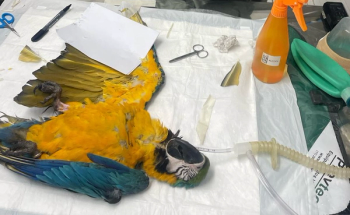
- dvm360 January 2020
- Volume 51
- Issue 1
Whats new in veterinary vaccinology?
Todays veterinarians have choices in vaccine formulations beyond the standard killed or modified-live formulations. But more options can also make for more confusion.
2002lubava1981 / stock.adobe.com
Vaccinology has long been at the heart of infectious disease prevention in veterinary medicine. Historically, modified-live virus (MLV) vaccines and killed vaccines have been the “go-to” formulations for veterinary patients. More recently, new vaccine formulations, such as the subunit vaccine, have entered the veterinary vaccinology landscape and expanded the number of options from which veterinarians can choose.
More options can certainly be a good thing, but they can also make for confusion when trying to decide which formulation would be best for a particular patient.
To wade through this changing landscape, Laurel Gershwin, DVM, PhD, DACVM, a professor at the University of California, Davis, School of Veterinary Medicine, presented information on traditional and newer vaccine technologies at
“Understanding the different types of vaccines is important,” Dr. Gershwin said, “because you have to know what kind of immune response you need. The pathogenesis of a particular disease may lend itself better to one particular vaccine versus another.”
For example, to immunize a horse against tetanus, a vaccine that induces an antibody response to neutralize the toxin would be ideal. To immunize against a systemic viral disease, a vaccine that induces an antibody response and cell-mediated immunity (CMI) may be preferable.
Regardless of formulation, the vaccine itself should be able to be administered with minimal discomfort to the patient and without adverse side effects.
Immunology in a nutshell
Before discussing vaccine formulations, Dr. Gershwin gave a brief refresher-“immunology in a nutshell,” in her words-on pathogen classifications, protective mechanisms against pathogens, and immune cells.
Pathogens can be intracellular, extracellular or facultative intracellular. Intracellular pathogens, which are primarily viruses, prefer moving from cell to cell but may also spend time in the vasculature; these pathogens are susceptible to antibodies. Extracellular pathogens, such as Staphylococcus, can often be eliminated with antibodies and phagocytic cells. Facultative intracellular pathogens, such as bacteria that can grow and replicate within phagocytic cells, often require an immune response as for intracellular pathogens.
Different immune cells, she explained, elicit different immune responses: CD8 cytotoxic lymphocytes activate CMI, while CD4 T-helper cells activate antibody production.
The major histocompatibility complexes (MHC), which are cell surface molecules, also play critical immunologic roles. MHC class I molecules are present on nearly every cell and present antigens that are produced within a cell and recognized by cytotoxic T cells, activating CMI. MHC class II molecules are present only on specific immune cells and present extracellular, foreign antigens that are recognized by T-helper cells, eliciting antibody production.
Traditional vaccine formulations
MLVs, such as the canine distemper vaccine, contain attenuated virus that replicates in the cytosol and is ultimately displayed by MHC class I. MLVs can also produce MHC class II antigen presentation. Thus, MLVs can stimulate both CMI and antibody responses.
MLVs have several drawbacks, however, including reversion to virulence. Additionally, viral attenuation may still be too strong for a suppressed immune system. Also, if a patient is seropositive, it is not possible to differentiate whether the seropositivity is due to MLV vaccination or previous infection.
Killed vaccines, such as the rabies vaccine, are usually administered with an adjuvant. The killed virus enters macrophages and dendritic cells and is degraded into peptide fragments that are presented via MHC class II.
Differentiation is also not possible with killed vaccines. This drawback of traditional vaccine formulations can be especially problematic for FIV-positive cats. Extra testing, such as polymerase chain reaction, could differentiate but is expensive and time-consuming.
New vaccine formulations
New vaccination formulations, known as DIVA vaccines (differentiating infected from vaccinated animals), address this differentiation problem. Examples include subunit vaccines, recombinant vectored vaccines and DNA vaccines. Through different technologies, each of these formulations is stripped down to contain only the elements that induce a protective immune response.
Subunit vaccines are developed by inserting only the immunogenic proteins from the surface of a bacterium or virus into a plasmid (e.g. yeast). These proteins are then harvested and developed into a vaccine. Selecting only the proteins that will induce a protective immune response makes subunit vaccines safer by leaving out substances that may produce adverse side effects.
Viruslike particle (VLP) vaccines, such as the porcine circovirus type 2 vaccine, are subunit vaccines comprised of viral structural proteins that can self-assemble into VLPs. Also called nanoparticle vaccines, VLP vaccines can stimulate CMI and antibody responses.
Because subunit vaccines present only the relevant antigens to the immune system, they tend to induce a stronger immune response. They can also increase the immunogenicity of native proteins. These vaccines, Dr. Gershwin noted, are more likely to elicit an antibody response than CMI. An adjuvant is typically required to ensure long-term immunity.
Recombinant vectored vaccines, such as the rinderpest vaccine, use a viral or bacterial vector to produce proteins that will generate a protective immune response. Poxviruses have been a popular viral vector, given their large genome.
To develop a recombinant viral vector vaccine, for example, the pox-related genetic material is removed, and the genes that code for the selected protective proteins are inserted. After the viral vector is injected into the patient, the vector will undergo limited intracellular replication, express the genes and subsequently induce CMI and antibody responses.
Recombinant vectored vaccines, Dr. Gershwin explained, have all of the advantages of MLV and subunit vaccines.
DNA vaccines, such as the canine melanoma vaccine, have shown at least initial promise in veterinary vaccinology. They are made by inserting the DNA sequence that codes for protective proteins into a plasmid.
DNA vaccines are placed within a liposome and injected intramuscularly with a specialized injector. They typically produce strong CMI.
The canine melanoma vaccine is made by inserting the human tyrosinase gene into the plasmid. Tyrosinase is overexpressed in animal and human melanoma cells. In theory, using the human tyrosinase gene “will stimulate an immune response against the animal's melanocytes,” Dr. Gershwin said. Unfortunately, the vaccine may not be very effective in dogs because dogs with melanoma are usually quite sick by the time the vaccine is given.
Bringing it together
Beyond MLVs and killed vaccines, the new vaccine formulations hold promise for providing adequate protection against infectious diseases in veterinary patients. Deciding which formulation to use will depend on the desired type of immune response.
Dr. JoAnna Pendergrass received her DVM from the Virginia-Maryland College of Veterinary Medicine. Following veterinary school, she completed a postdoctoral fellowship at Emory University's Yerkes National Primate Research Center. Dr. Pendergrass is the founder and owner of JPen Communications, a medical communications company.
Articles in this issue
almost 5 years ago
New cancer screening test for dogs now availablealmost 6 years ago
The next recession is coming. Here’s what to do nowalmost 6 years ago
Women’s veterinary leadership group names new presidentalmost 6 years ago
A refuge from violence for pets and peoplealmost 6 years ago
Managing recurrent UTIs in petsalmost 6 years ago
An update on tick control from Michael Dryden at Fetch dvm360almost 6 years ago
A DVM at the DMValmost 6 years ago
Florida names new interim veterinary school deanalmost 6 years ago
The ABCs of veterinary dentistry: U is for ulcers—what a pain!almost 6 years ago
dvm360's top news stories of 2019Newsletter
From exam room tips to practice management insights, get trusted veterinary news delivered straight to your inbox—subscribe to dvm360.






